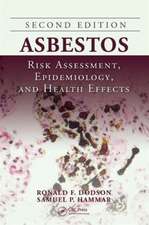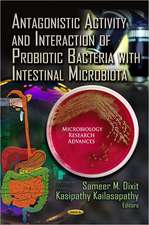Aging and Vulnerability to Environmental Chemicals: Issues in Toxicology, cartea 16
Diana Anderson, Tim Marrs, Mike D Waters, Martin F. Wilks Editat de Bernard Weissen Limba Engleză Hardback – 12 dec 2012
The world's aging populations, with age-related disorders affecting every organ system, are generating medical care costs rising at an unsustainable rate. Although such disorders are expected, we are now beginning to ask whether exposures to toxic environmental chemicals hasten or account for their onset. This book provides a detailed review of current knowledge about the possible associations between a variety of chemical contaminants and adverse effects later in life. It will serve as a guide to policy decisions about protecting us from chemical exposures that distort the aging process. It provides a guide to current understanding of how our contaminated environment may be influencing the aging process and contains examples of approaches that will help us undertake further research on this topic. It will help alert policy makers to the implications of chemical pollution for aging populations and will help formulate initiatives for environmental protection. The book provides a comprehensive view of how environmental exposures may alter the health of our aging population. For readers engaged in environmental research, or aging research, it will highlight a number of questions that need more attention For other readers, they will learn something about the kind of exposures they should avoid or that they should prompt policy makers to reduce or eliminate.
Din seria Issues in Toxicology
- 5%
 Preț: 1253.11 lei
Preț: 1253.11 lei - 5%
 Preț: 1326.01 lei
Preț: 1326.01 lei - 5%
 Preț: 1538.96 lei
Preț: 1538.96 lei - 14%
 Preț: 2480.57 lei
Preț: 2480.57 lei - 5%
 Preț: 1361.12 lei
Preț: 1361.12 lei - 9%
 Preț: 1031.61 lei
Preț: 1031.61 lei - 14%
 Preț: 1211.87 lei
Preț: 1211.87 lei - 14%
 Preț: 1357.63 lei
Preț: 1357.63 lei - 5%
 Preț: 1134.46 lei
Preț: 1134.46 lei - 14%
 Preț: 1314.76 lei
Preț: 1314.76 lei - 14%
 Preț: 1404.09 lei
Preț: 1404.09 lei - 5%
 Preț: 1495.86 lei
Preț: 1495.86 lei - 5%
 Preț: 1508.68 lei
Preț: 1508.68 lei - 5%
 Preț: 1551.74 lei
Preț: 1551.74 lei - 5%
 Preț: 1268.59 lei
Preț: 1268.59 lei - 5%
 Preț: 1537.11 lei
Preț: 1537.11 lei - 5%
 Preț: 1526.14 lei
Preț: 1526.14 lei - 5%
 Preț: 2534.03 lei
Preț: 2534.03 lei - 5%
 Preț: 1537.11 lei
Preț: 1537.11 lei - 5%
 Preț: 1440.92 lei
Preț: 1440.92 lei - 14%
 Preț: 1230.53 lei
Preț: 1230.53 lei - 5%
 Preț: 1341.43 lei
Preț: 1341.43 lei - 14%
 Preț: 1387.76 lei
Preț: 1387.76 lei - 5%
 Preț: 1201.01 lei
Preț: 1201.01 lei - 14%
 Preț: 1218.32 lei
Preț: 1218.32 lei - 14%
 Preț: 949.86 lei
Preț: 949.86 lei - 5%
 Preț: 1300.31 lei
Preț: 1300.31 lei - 5%
 Preț: 1087.58 lei
Preț: 1087.58 lei - 5%
 Preț: 1073.50 lei
Preț: 1073.50 lei - 14%
 Preț: 1136.73 lei
Preț: 1136.73 lei - 5%
 Preț: 642.03 lei
Preț: 642.03 lei - 14%
 Preț: 1092.34 lei
Preț: 1092.34 lei - 5%
 Preț: 1045.29 lei
Preț: 1045.29 lei - 5%
 Preț: 1054.02 lei
Preț: 1054.02 lei - 5%
 Preț: 1158.47 lei
Preț: 1158.47 lei - 9%
 Preț: 1242.36 lei
Preț: 1242.36 lei - 5%
 Preț: 1440.62 lei
Preț: 1440.62 lei - 9%
 Preț: 1239.74 lei
Preț: 1239.74 lei - 9%
 Preț: 1034.00 lei
Preț: 1034.00 lei - 9%
 Preț: 1244.07 lei
Preț: 1244.07 lei - 9%
 Preț: 1169.42 lei
Preț: 1169.42 lei - 9%
 Preț: 1172.99 lei
Preț: 1172.99 lei - 9%
 Preț: 1031.38 lei
Preț: 1031.38 lei - 9%
 Preț: 1032.48 lei
Preț: 1032.48 lei - 5%
 Preț: 833.22 lei
Preț: 833.22 lei
Preț: 1337.71 lei
Preț vechi: 1408.11 lei
-5% Nou
Puncte Express: 2007
Preț estimativ în valută:
255.96€ • 267.25$ • 211.85£
255.96€ • 267.25$ • 211.85£
Carte tipărită la comandă
Livrare economică 05-19 aprilie
Preluare comenzi: 021 569.72.76
Specificații
ISBN-13: 9781849734189
ISBN-10: 1849734186
Pagini: 484
Ilustrații: colour illustrations
Dimensiuni: 163 x 236 x 41 mm
Greutate: 1.13 kg
Editura: Royal Society Of Chemistry
Seria Issues in Toxicology
ISBN-10: 1849734186
Pagini: 484
Ilustrații: colour illustrations
Dimensiuni: 163 x 236 x 41 mm
Greutate: 1.13 kg
Editura: Royal Society Of Chemistry
Seria Issues in Toxicology
Cuprins
Parkinson’s Disease; Cognitive dysfunction and lead; Cardiovascular disease, metabolic syndrome; Breast cancer; Prostate cancer; Kidney disease; Liver disease; Osteoporosis; Immune system disorders; Male reproductive tract disorders; Female reproductive tract disorders; Air Pollutants; Mercury; Manganese; Aluminium; Cadmium; PCBs and Dioxins; Bisphenol A; Obesogens; Subject Index
Notă biografică
Dr. Bernard Weiss is Professor of Environmental Medicine at the University of Rochester School of Medicine and Dentistry, where he has been a member of the faculty since 1965. He is also a member of its Environmental Health Sciences Center. Before coming to Rochester, he served on the faculty of the Johns Hopkins School of Medicine, and, earlier, held an appointment at the U.S. Air Force School of Aviation Medicine. Dr. Weiss has served as a member of many committees and panels devoted to toxicology and environmental health, including those organized by the U.S. Environmental Protection Agency's Science Advisory Board, and the National Academy of Sciences. He is especially concerned with risk assessment issues arising from the effects of environmental chemicals on brain development and brain aging, and with the role played by sex differences. He is the editor or co-editor of seven books and monographs and author or co-author of over 250 articles. His special interests and publications lie primarily in areas that involve chemical influences on behavior; these include the neurobehavioral toxicology of metals such as lead, mercury and manganese; developmental toxicants such as dioxin; solvents such as toluene and methanol; endocrine disruptors such as phthalates; and air pollutants such as ozone. His current research projects, supported by NIH, examine the effects of Bisphenol A on brain sexual differentiation.
Textul de pe ultima copertă
Many of the world's societies face an unprecedented demographic challenge. They are aging at such a rapid rate that it threatens to overwhelm their resources, economies, and political landscape. Although aging is not a disease, its manifestations are extensively treated, often at staggering costs. Any strategy that reduces these costs would pay immense dividends. One such strategy emerges from how the environment shapes the aging process. Aging and Vulnerability to Environmental Chemicals addresses one largely overlooked aspect of our environment. It is focused on how chemical agents affect the health of aging populations. Like early development, aging is a life stage during which vulnerability to toxic chemicals is intensified and in many ways duplicates the imperfect defences deployed by the immature organism. One feature common to both early and late phases is a reduced capacity to compensate for damage. In the first case, the functional mechanisms have yet to evolve. In the second, the compensatory mechanisms have weakened progressively. The chemical revolution has flooded the world with new chemicals that permeate every aspect of our lives. Although they bring significant benefits, they exact a heavy price. We are now exposed to thousands of chemicals whose toxic properties still elude us and whose chemical signatures can be found in our tissues. By improving our knowledge of how our contaminated environment contributes to declining health, we can act to avert further strains on our beleaguered societies. Written by experts on the environmental exposures that jeopardize optimal aging, this book serves as an excellent foundation for policy decisions. It will be read primarily by those engaged in environmental or aging research. More general readers will benefit from learning about the chemicals to avoid.
Descriere
This book provides a comprehensive review of how environmental exposures may alter the health of our aging population.












